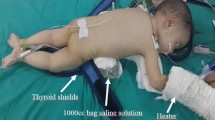Abstract
We aim to compare the outcomes, including the morbidity and success rates in children undergoing percutaneous nephrolithotomy (PCNL) using different sized devices. According to the size of instruments used during surgery, three different groups (ultra-mini-PCNL, mini-PCNL and adult size PCNL) were composed and the outcomes were compared between the groups. PCNL was applied to 225 renal units of 220 children, including 5 patients with bilateral kidney stones. Percutaneous nephrolithotomy was performed using adult instruments (24 F) in 82 renal units, using pediatric instruments (18 F) in 89 and using minimal-size instruments (9.5 F) in 50. One-hundred and twenty-four girls and 96 boys with a mean age of 8.33 (<17) years were assessed. Stone-free rates were 78 % in group 1 (n = 39) using 9.5 F nephroscope, 75.8 % in group 2 (n = 69) using 18 F nephroscope and 71.4 % in group 3 (n = 60) using 24 F nephroscope. Time to access the collecting system, operative time, duration of nephrostomy and average postoperative hospital stay did not differ between the groups. However, mean hematocrit drop and stone burden were significantly lesser in ultra-mini-PCNL group. There was no significant difference in the complication rates between the groups, according to the modified Clavien classification system. As the important complication of PCNL, bleeding seems to be associated with diameter of dilatation, calibre of nephroscopes and stone burden. To reduce the certain complications, pediatric type of instruments is suitable but the use of adult instruments and techniques may achieve equal results.

Similar content being viewed by others
References
Muslumanoglu AY, Binbay M, Yuruk E et al (2011) Updated epidemiologic study of urolithiasis in Turkey. I: changing characteristics of urolithiasis. Urol Res 39:309–314
Sarica K (2006) Pediatric urolithiasis: etiology, specific pathogenesis and medical treatment. Urol Res 34:96–101
Tekgül S, Dogan HS, Erdem E et al (2015) Guideline on pediatric urology 1-130. Available at: http://uroweb.org/wp-content/uploads/EAU-Guidelines-Paediatric-Urology-2015.pdf
Celik H, Camtosun A, Altintas R et al (2015) Percutaneous nephrolithotomy for paediatric stone disease. EMJ Urol 3:73–76
Özden E, Sahin A, Tan B et al (2008) Percutaneous renal surgery in children with complex stone. J Pediatr Urol 4:295–298
Erdenetsesteg G, Manohar T, Singh H et al (2006) Endourological management of pediatric urolithiasis: proposed clinical guidelines. J Endourol 20:737–748
Altintas R, Oguz F, Tasdemir C et al (2014) The importance of instrument type in paediatric percutaneous nephrolithotomy. Urolithiasis 42:149–153
Unsal A, Resorlu B, Kara C et al (2010) Safety and efficacy of percutaneous nephrolithotomy in infants, preschool age, and older children with different sizes of instruments. Urology 76:247–252
Bilen CY, Kocak G, Kitirci O et al (2007) Percutaneous nephrolithotomy in children: lessons learned in 5 years at a single institution. J Urol 177:1867–1871
Bartosh SM (2004) Medical management of paediatric stone disease. Urol Clin North Am 31:575–587
Akinci M, Esen T, Tellaloglu S et al (1991) Urinary stone disease in Turkey: an updated epidemiological study. Eur Urol 20:200–203
Bastug F, Gunduz Z, Tulpar S et al (2013) Urolithiasis in infants: evaluation of risk factors. World J Urol 31:1117–1122
Söylemez H, Sancaktutar AA, Altunoluk B et al (2012) Re: radiation protection in pediatric radiology. Urol Res 40:621–622
Woodside JR, Steven GF, Stark GL et al (1985) Percutaneous stone removal in children. J Urol 134:1166–1167
Traxer O, Smith TG, Pearle MS et al (2001) Renal parenchymal injury after standard and mini percutaneous nephrostolithotomy. J Urol 165:1693–1695
Tekin I, Tekgul S, Bakkaloglu M et al (1998) Results of extracorporeal shock wave lithotripsy in children, using the Dornier MPL 9000 lithotriptor. J Pediatr Surg 33:1257–1259
Desai, Kukreja RA, Patel SH et al (2004) Percutaneous nephrolithotomy for complex pediatric renal calculus disease. J Endourol 18:23e7
Kapoor R, Solanki F, Signhania P et al (2008) Safety and efficacy of percutaneous nephrolithotomy in the pediatric population. J Endourol 22:637e40
Michel MS, Trojan L, Rassweiler JJ (2007) Complications in percutaneous nephrolithotomy. Eur Urol 51:899–906
Unsal A, Resorlu B, Atmaca AF et al (2012) Prediction of morbidity and mortality after percutaneous nephrolithotomy by using the Charlson Comorbidity Index. Urology 79:55–60
Zeren S, Satar N, Bayazit Y et al (2002) Percutaneous nephrolithotomy in the management of pediatric renal calculi. J Endourol 16:75–78
Raza A, Turna B, Smith G et al (2005) Pediatric urolithiasis: 15 years of local experience with minimally invasive endourological management of paediatric calculi. J Urol 174:682–685
Bayrak O, Erturhan S, Seckiner I et al (2013) Reliability of percutaneous nephrolithotomy in pediatric patients: comparison of complications with those in adults. Korean J Urol 54:383–387
Kumar S, Bag S, Ganesamoni R et al (2012) Risk factors for urosepsis following percutaneous nephrolithotomy: role of 1 week of nitrofurantoin in reducing the risk of urosepsis. Urol Res 40:79–86
Daggulli M, Sancaktutar AA, Dede O et al (2015) Minimally invasive percutaneous nephrolithotomy: an effective treatment for kidney stones in infants under 1 year of age. A single-center experience. Urolithiasis. doi:10.1007/s00240-015-0787-z (Epub ahead of print)
Acknowledgments
We do not acknowledge any person or institute for this research.
Author information
Authors and Affiliations
Corresponding author
Ethics declarations
This study was approved by the Research and Publication Ethics Boards in Malatya/Turkey.
Conflict of interest
The authors declare that they have no competing interests and received no financial support for the research.
Rights and permissions
About this article
Cite this article
Celik, H., Camtosun, A., Dede, O. et al. Comparison of the results of pediatric percutaneous nephrolithotomy with different sized instruments. Urolithiasis 45, 203–208 (2017). https://doi.org/10.1007/s00240-016-0887-4
Received:
Accepted:
Published:
Issue Date:
DOI: https://doi.org/10.1007/s00240-016-0887-4



